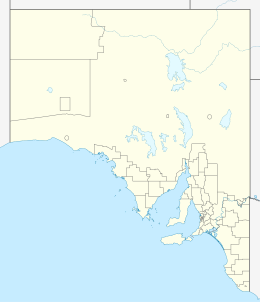| Geography | |
|---|---|
| Location | Spencer Gulf |
| Coordinates | 34°38′49″S 136°10′53″E / 34.647°S 136.181292°E[1] |
| Archipelago | Sir Joseph Banks Group |
| Highest elevation | 26 m (85 ft) |
| Administration | |
| South Australia | |
| Demographics | |
| Population | 0 |
Sibsey Island is an island in the Australian state of South Australia located in Spencer Gulf within the Sir Joseph Banks Group. It was discovered on 21 February 1802 by Matthew Flinders.[2] Currently, the island is uninhabited.[verification needed]
Geography
[edit]Sibsey Island is the westernmost member of the Sir Joseph Banks group. There are two anchorages on the island, one on the western side of the island, and another on the east. The nearest island within the Sir Joseph Banks Group is English Island, which lies to the north-east. There is a navigational aid located on 2m high pile on the island's highest point, i.e. 26m above sea level.[3] Dangerous Reef, a nearby reef, makes approaching the island in large craft hazardous. [clarification needed]
Wildlife
[edit]Australian sea lions from nearby English Island are often seen on the rocks near to Sibsey. Seabirds nest on the island, but there are no other large animals present. Marine predators often hunt in the channel between Sibsey and English Islands. The island is part of the Sir Joseph Banks Islands Important Bird Area, identified as such by BirdLife International because of its importance as a breeding site for seabirds and for Cape Barren geese.[4] Guano was collected from the island in the early 20th century. One party to the island c. 1916 left two members on the island for twelve days, during which time they survived by eating little penguins and their eggs.[5] In 2004, "few" little penguins were present on Sibsey Island. As of 2011, the colony's status is unknown.[6]
Economy
[edit]The island has no native economy, being uninhabited. However, the waters surrounding it are used extensively by recreational fishermen. The nearby Dangerous Reef is also a popular tourism spot, with scuba diving operators taking advantage of the natural formations and fish stocks.[verification needed] It is a significant bird, sea lion and great white shark breeding area.[7] The area is also covered under the Lower Eyre Peninsula Aquaculture Policy.[citation needed]
Protected area status
[edit]Sibsey Island first obtained protected area status as a fauna conservation reserve declared under the Crown Lands Act 1929-1966 on 16 March 1967.[8]
See also
[edit]References
[edit]- ^ "Search results for 'Sibsey Island' with the following datasets selected – 'NPW and Conservation Properties', 'Local Government Areas' and 'Gazetteer'". South Australian Government. Retrieved 11 July 2018.
- ^ Flinders, Matthew (1966) [1814]. A Voyage to Terra Australis : undertaken for the purpose of completing the discovery of that vast country, and prosecuted in the years 1801, 1802, and 1803 in His Majesty's ship the Investigator, and subsequently in the armed vessel Porpoise and Cumberland Schooner; with an account of the shipwreck of the Porpoise, arrival of the Cumberland at Mauritius, and imprisonment of the commander during six years and a half in that island (Facsimile ed.). Adelaide: Libraries Board of South Australia. pp. 228–229. Retrieved 5 January 2014.
- ^ "Listed by State (i.e. lighthouses & navigation aids)". Australian Lighthouses. Archived from the original on 26 January 2014. Retrieved 5 January 2014.
- ^ "IBA: Sir Joseph Banks Islands". Birdata. Birds Australia. Archived from the original on July 6, 2011. Retrieved 2011-10-10.
- ^ "ENGLISH LAD'S ADVENTURES Port Lincoln, July 19". The Express and Telegraph. 1916-07-24. p. 1. Retrieved 2015-11-27.
- ^ Wiebkin, A. S. (2011) Conservation management priorities for little penguin populations in Gulf St Vincent. Report to Adelaide and Mount Lofty Ranges Natural Resources Management Board. South Australian Research and Development Institute (Aquatic Sciences), Adelaide. SARDI Publication No. F2011/000188-1. SARDI Research Report Series No.588. 97pp.
- ^ "AMCS Submission on Lower Eyre Peninsula Aquaculture Management Plan". Conservation Council of South Australia. 2005. Archived from the original on 2006-08-24. Retrieved 2006-10-12.
- ^ "CROWN LANDS ACT, 1929-1966: FAUNA CONSERVATION RESERVES DEDICATED" (PDF). THE SOUTH AUSTRALIAN GOVERNMENT GAZETTE. Government of South Australia. 16 March 1967. pp. 961–962. Retrieved 5 February 2018.
External links
[edit]- Account of Matthew Flinders' discovery of the island
- Google Maps photograph of Sibsey and surrounding islands
- The Sir Joseph Banks Island Group
- EYre Peninsula Parks guide- Department for Environment and Heritage
